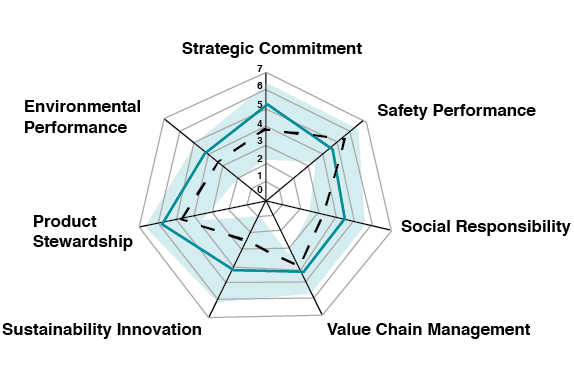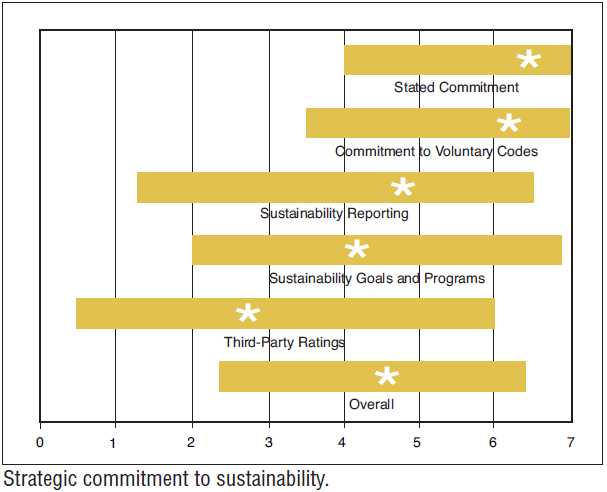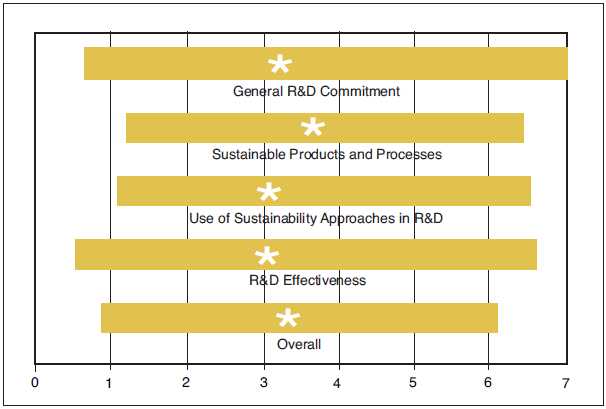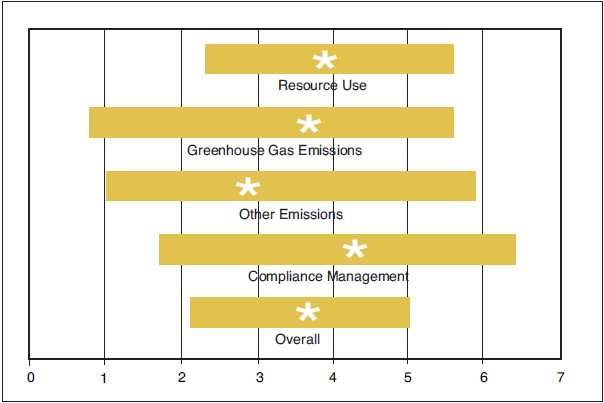Sustainability Index

What is the AIChE Sustainability Index?
What makes the Index unique?
- Benchmark your performance among peers
- Assess your performance against well-defined metrics on an on-going basis
- Measure progress toward best practices at regular intervals
- Access unbiased, expert interpretation of publicly available technical data
- Better understand public perception of your company’s sustainability efforts
Seven Metrics of the AIChE Sustainability Index
Explore the seven metrics that make up the AIChE Sustainability Index based on performance of the 11 major chemical companies (Air Products, Akzo Nobel, Ashland, BASF, Celanese, Dow, DuPont, Eastman, Lyondell, Praxair, and Rohm & Haas) that were included in the inaugural analysis of AIChE SI in 2008:
Strategic Commitment
Strategic commitment includes the following assessment criteria:
- Stated Commitment — public commitment to excellence in environmental and social performance throughout a company’s value chain
- Commitment to Voluntary Codes — public commitment to voluntary codes and standards, including Responsible Care, Global Compact, and others
- Sustainability Reporting — timely and comprehensive public reporting of sustainability performance
- Sustainability Goals and Programs — a comprehensive set of goals and programs that are specific and challenging
- Third-Party Ratings — respected agencies’ ratings on company-wide sustainability management and reporting.

On average, the companies received high marks on stated commitment and commitment to voluntary codes, and lower scores on sustainability reporting and sustainability goals and programs. They also scored somewhat poorly on third-party ratings (such as the Dow Jones Sustainability Index and FTSE4Good). The ranges, however, show considerable gaps between the top and bottom performers for each criterion.
All of the major chemical companies in this analysis have made public commitments to some aspects of sustainability, and nine of the 11 have extended these commitments beyond internal environmental, health and safety (EHS) performance and product safety to include resource efficiency, product environmental performance, and supplier performance. Nevertheless, commitments need to be supported by systems in place, including accountability through public reporting and clear targets and initiatives. Although a few of the companies have published well-respected, award-winning sustainability reports, many remain limited to reporting internal EHS performance and anecdotal success stories. Only a handful of chemical companies have developed clear and comprehensive sustainability targets.
Sustainability Innovation
Sustainability innovation considers:
- General R&D Commitment — corporate commitment to research and development, as evident in the amount of R&D expenditure per net sales
- Sustainable Products and Processes — development of products and processes with superior environmental, social and economic performance
- Sustainability Approaches in R&D — use of sustainability considerations and decision-support tools in R&D and innovation processes
- R&D Effectiveness — results of the R&D investment, as reflected in the number of patents issued and commercialization of new products that enhance environmental and social sustainability.

The wide ranges of the innovation sub-scores reflect the diversity of the chemical industry — from those applying established technologies for the efficient production of commodity materials to those relying on innovative products. Companies engaged in developing sustainable products and processes have largely focused on environmental performance over a product’s lifecycle, especially in terms of the environmental impacts of customer use of the product. Reducing greenhouse gases and improving energy efficiency are the main drivers. A few firms are also engaged in improving customers safety and developing innovations around critical social needs, such affordable healthcare and clean water for the developing world.
Environmental Performance
Environment performance is based on:
- Resource Use — intensity of energy, material and water consumption, and use of renewable sources of energy and materials Greenhouse Gas Emissions — intensity of greenhouse gas emissions
- Other Emissions — air emissions, wastewater, and hazardous waste releases
- Compliance Management — environmental liability, fines and penalties, and environmental capital investment.

The chemical industry in general has made considerable progress on environmental performance over the past few decades. The recent performance of the 11 companies included in this analysis also indicates continuous improvements — for a variety of emissions, there is a clear downward trend, despite increasing production.
Safety Performance
Safety performance encompasses:
- Employee Safety — recordable and days-away-fromwork injury rates
- Process Safety — number and trend of process safety incidents, normalized by number of employees, and occurrence of major safety incidents
- Plant Security — presence of an adequate plant security management system, represented by completion of a Responsible Care plant security audit.
 Regarding employee safety, the chemical industry continues to be among the best in the manufacturing sector. Behavior-based safety processes are becoming more widely adopted. Process safety performance sub-scores, however, cover a wide range. Based on companies’ selfreported data and trends, the number of process safety incidents per 1,000 employees for the 11 firms assessed is generally decreasing. However, three of the companies have experienced a significant increase in process safety incidents, based on a three-year trend. Responsible Care plant security audits have been completed by almost all (10 out of 11) of the companies reviewed.
Regarding employee safety, the chemical industry continues to be among the best in the manufacturing sector. Behavior-based safety processes are becoming more widely adopted. Process safety performance sub-scores, however, cover a wide range. Based on companies’ selfreported data and trends, the number of process safety incidents per 1,000 employees for the 11 firms assessed is generally decreasing. However, three of the companies have experienced a significant increase in process safety incidents, based on a three-year trend. Responsible Care plant security audits have been completed by almost all (10 out of 11) of the companies reviewed.
Product Stewardship
Product stewardship includes:
- Assurance System — product stewardship policies and goals, incorporation of a Responsible Care product safety process, and engagement of value-chain partners to assure product safety
- Risk Communication — risk communication policies and goals, incorporation of a Responsible Care risk communication process, and preparation to meet REACH requirements
- Legal Proceedings — involvement in major legal proceedings related to product safety, risk and toxicity.
 All of the 11 chemical companies assessed have implemented Responsible Care product safety and risk communication processes or equivalents. Some have also implemented more-proactive standards than required by Responsible Care, which helps to explain the ranges in scores. Such programs include value-chain engagement, education, and partnership efforts to identify and manage product safety and environmental risks. Furthermore, all of the participating companies are engaged in preparation for REACH compliance. As expected, companies with a strong European presence appear to be better prepared.
All of the 11 chemical companies assessed have implemented Responsible Care product safety and risk communication processes or equivalents. Some have also implemented more-proactive standards than required by Responsible Care, which helps to explain the ranges in scores. Such programs include value-chain engagement, education, and partnership efforts to identify and manage product safety and environmental risks. Furthermore, all of the participating companies are engaged in preparation for REACH compliance. As expected, companies with a strong European presence appear to be better prepared.
Social Responsibility
Social responsibility consists of:
- Stakeholder Partnerships — extent of stakeholder engagement and partnership programs at the project, facility and corporate levels
- Social Investment — contributions through employment, philanthropy and community development projects
- Image in the Community — company image as indicated by reputable awards and recognition programs, including “most admired” and “best employer” ratings.
All chemical companies have stakeholder engagement and partnership programs, although their scope varies considerably. All of the 11 evaluated have facility-level Community Advisory Panels (CAPs), and some have also established partnerships with nongovernmental and community organizations to address specific issues. A few have also established programs with community and opinion leaders to stay informed about emerging issues and concerns.
The chemical industry continues to be a source of employment and economic development. The extent of employment varies, from 0.5 to almost 4 employees per million dollars in net sales, with specialty materials and industrial gas producers leading in the normalized employment figures. Furthermore, the companies reviewed contribute 0.03% to 0.13% of their net revenues for various philanthropic and community development projects — many with emphasis on science and technology education. The image of chemical companies in the community also varies widely, based on third-party recognitions.
Value-Chain Management
Value-chain management relates to:
- Environmental Management Systems — presence of an environmental management system (EMS) at the corporate and facility levels
- Supply Chain Management — policies and procedures related to suppliers’ sustainability, presence of sustainability evaluation and audits for first-tier suppliers, and management of second- and higher-tier suppliers.
Join the AIChE Sustainability Index to start managing your sustainability efforts
Companies can obtain confidential reports of their own performance metrics for comparison to the aggregated industry and sector metrics for a reasonable subscription fee.
Join the AIChE Sustainability Index by contacting ifs@aiche.org
As a subscribing firm you will receive:
- The details behind the computations made to obtain your company’s metrics
- Comparisons to the benchmark averages of other indexed companies for better understanding of current sustainability practices in relevant industries
- Recommendations on how to improve sustainability practices and reporting of them based on how the community and public view current company sustainability practices
- Inclusion as desired in all Sustainability Index press materials
- A seat at the Sustainability Index roundtable to improve your understanding of sustainability measures and help the Index evolve to best meet the your needs
